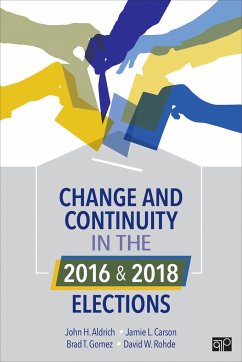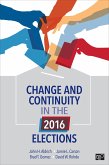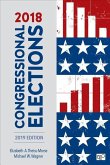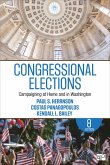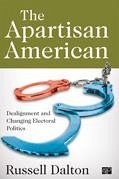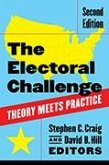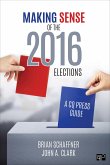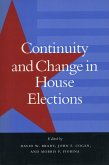John Aldrich, Jamie L Carson, Brad T Gomez, David Rohde
Change and Continuity in the 2016 and 2018 Elections
John Aldrich, Jamie L Carson, Brad T Gomez, David Rohde
Change and Continuity in the 2016 and 2018 Elections
- Broschiertes Buch
- Merkliste
- Auf die Merkliste
- Bewerten Bewerten
- Teilen
- Produkt teilen
- Produkterinnerung
- Produkterinnerung
This text meticulously and accessibly explains the National Election Studies data and analyzes its importance and impact, covering the most recent presidential and Congressional elections, voter turnout, and the social forces, party loyalties, and prominent issues that affect voting behavior.
Andere Kunden interessierten sich auch für
![Change and Continuity in the 2016 Elections Change and Continuity in the 2016 Elections]() John AldrichChange and Continuity in the 2016 Elections125,99 €
John AldrichChange and Continuity in the 2016 Elections125,99 €![2018 Congressional Elections 2018 Congressional Elections]() Elizabeth A Theiss-Morse2018 Congressional Elections51,99 €
Elizabeth A Theiss-Morse2018 Congressional Elections51,99 €![Congressional Elections Congressional Elections]() Paul S HerrnsonCongressional Elections115,99 €
Paul S HerrnsonCongressional Elections115,99 €![The Apartisan American The Apartisan American]() Russell J. DaltonThe Apartisan American76,99 €
Russell J. DaltonThe Apartisan American76,99 €![The Electoral Challenge The Electoral Challenge]() The Electoral Challenge115,99 €
The Electoral Challenge115,99 €![Making Sense of the 2016 Elections Making Sense of the 2016 Elections]() Brian F SchaffnerMaking Sense of the 2016 Elections51,99 €
Brian F SchaffnerMaking Sense of the 2016 Elections51,99 €![Continuity and Change in House Elections Continuity and Change in House Elections]() Continuity and Change in House Elections37,99 €
Continuity and Change in House Elections37,99 €-
-
-
This text meticulously and accessibly explains the National Election Studies data and analyzes its importance and impact, covering the most recent presidential and Congressional elections, voter turnout, and the social forces, party loyalties, and prominent issues that affect voting behavior.
Hinweis: Dieser Artikel kann nur an eine deutsche Lieferadresse ausgeliefert werden.
Hinweis: Dieser Artikel kann nur an eine deutsche Lieferadresse ausgeliefert werden.
Produktdetails
- Produktdetails
- Verlag: Sage Publications
- Seitenzahl: 528
- Erscheinungstermin: 13. August 2019
- Englisch
- Abmessung: 226mm x 152mm x 25mm
- Gewicht: 703g
- ISBN-13: 9781544356778
- ISBN-10: 1544356773
- Artikelnr.: 55803722
- Herstellerkennzeichnung
- Libri GmbH
- Europaallee 1
- 36244 Bad Hersfeld
- gpsr@libri.de
- Verlag: Sage Publications
- Seitenzahl: 528
- Erscheinungstermin: 13. August 2019
- Englisch
- Abmessung: 226mm x 152mm x 25mm
- Gewicht: 703g
- ISBN-13: 9781544356778
- ISBN-10: 1544356773
- Artikelnr.: 55803722
- Herstellerkennzeichnung
- Libri GmbH
- Europaallee 1
- 36244 Bad Hersfeld
- gpsr@libri.de
John H. Aldrich is Pfizer-Pratt University Professor of Political Science at Duke University. He is author of Why Parties: A Second Look (2011), coeditor of Positive Changes in Political Science (2007), and author of Why Parties (1995) and Before the Convention (1980). He is a past president of both the Southern Political Science Association and the Midwest Political Science Association and is serving as president of the American Political Science Association. In 2001 he was elected a fellow in the American Academy of Arts and Sciences.
Tables and Figures Preface About the Authors INTRODUCTION Change and Continuity Voters and the Act of Voting Survey Research Sampling Plan of the Book PART I
THE 2016 PRESIDENTIAL ELECTION CHAPTER 1
The Nomination Struggle Who Ran The Rules of the Nomination System Strategy and the Candidates' Campaigns in 2016: The Electoral Setting and How the Candidates Won Their Nominations CHAPTER 2
The General Election Campaign The Strategic Context and Candidates' Choices Political Context, Overall Strategy, and Opening Moves From the Conventions to the Debates The End Game and the Struggle over Turnout Did the Campaign Make a Difference? CHAPTER 3
The Election Results The Election Rules The Pattern of Results State-by-State Results Electoral Change in the Postwar South The Electoral Vote Balance PART II
VOTING BEHAVIOR IN THE 2016 PRESIDENTIAL ELECTION CHAPTER 4
Who Voted? Voter Turnout, 1789-1916 Voter Turnout, 1920-2016 Voter Turnout among Social Groups Changes in Turnout after 1960 Election-Specific Factors Does Low Voter Turnout Matter? CHAPTER 5
Social Forces and the Vote How Social Groups Voted in 2016 How Social Groups Voted during the Postwar Years Why the New Deal Coalition Broke Down CHAPTER 6
Candidates, Issues, and the Vote Attitudes toward the Candidates Prospective Evaluations Issue Positions and Perceptions Issue Voting Criteria Apparent Issue Voting in 2016 Conclusion CHAPTER 7
Presidential Performance and Candidate Choice What Is Retrospective Voting? Evaluations of Government Performance on Important Problems Economic Evaluations and the Vote for the Incumbent Foreign Policy Evaluations and the Vote for the Incumbent Evaluations of the Incumbent The Impact of Retrospective Evaluations Conclusion CHAPTER 8
Party Loyalties, Policy Preferences, and the Vote Party Identification as Loyalty: The Original View Party Identification as Retrospective Evaluation: An Alternative View Party Identification, Polarization, and Identity: A Synthesis? Party Identification in the Electorate Hispanic Partisanship in 2008, 2012, and 2016 Party Identification and the Vote Policy Preferences and Performance Evaluations Conclusion PART III
THE 2016 CONGRESSIONAL ELECTIONS CHAPTER 9
Candidates and Outcomes in 2016 Election Outcomes in 2016 Candidates' Resources and Election Outcomes The 2016 Elections: The Impact on Congress The 2018 Elections and Beyond CHAPTER 10
The Congressional Electorate in 2016 Social Forces and the Congressional Vote Issues and the Congressional Vote Party Identification and the Congressional Vote Incumbency and the Congressional Vote The Congressional Vote as Referendum Presidential Coattails and the Congressional Vote Conclusion CHAPTER 11
The 2018 Congressional Elections The Pattern of Outcomes Assessing Victory and Explaining the Results National and Local Influences in Congressional Elections The 2018 Elections: The Impact on Congress The 2020 Elections and Beyond PART IV
THE 2016 AND 2018 ELECTIONS IN PERSPECTIVE CHAPTER 12
The 2016 and 2018 Elections and the Future of American Politics Are Midterm Elections Predictive? Prospects for the Democrats Prospects for the Republicans CHAPTER 13
The Dynamics of American Elections The Great Continuities: The Electoral System and the Party System The Great Change: Depolarization and the Return of Partisan Polarization Change and Continuity in Turnout Continuities in Electoral Partisanship Changes in the Partisan Electorate Change and Continuity in the U.S. Congress Appendix Notes Index
THE 2016 PRESIDENTIAL ELECTION CHAPTER 1
The Nomination Struggle Who Ran The Rules of the Nomination System Strategy and the Candidates' Campaigns in 2016: The Electoral Setting and How the Candidates Won Their Nominations CHAPTER 2
The General Election Campaign The Strategic Context and Candidates' Choices Political Context, Overall Strategy, and Opening Moves From the Conventions to the Debates The End Game and the Struggle over Turnout Did the Campaign Make a Difference? CHAPTER 3
The Election Results The Election Rules The Pattern of Results State-by-State Results Electoral Change in the Postwar South The Electoral Vote Balance PART II
VOTING BEHAVIOR IN THE 2016 PRESIDENTIAL ELECTION CHAPTER 4
Who Voted? Voter Turnout, 1789-1916 Voter Turnout, 1920-2016 Voter Turnout among Social Groups Changes in Turnout after 1960 Election-Specific Factors Does Low Voter Turnout Matter? CHAPTER 5
Social Forces and the Vote How Social Groups Voted in 2016 How Social Groups Voted during the Postwar Years Why the New Deal Coalition Broke Down CHAPTER 6
Candidates, Issues, and the Vote Attitudes toward the Candidates Prospective Evaluations Issue Positions and Perceptions Issue Voting Criteria Apparent Issue Voting in 2016 Conclusion CHAPTER 7
Presidential Performance and Candidate Choice What Is Retrospective Voting? Evaluations of Government Performance on Important Problems Economic Evaluations and the Vote for the Incumbent Foreign Policy Evaluations and the Vote for the Incumbent Evaluations of the Incumbent The Impact of Retrospective Evaluations Conclusion CHAPTER 8
Party Loyalties, Policy Preferences, and the Vote Party Identification as Loyalty: The Original View Party Identification as Retrospective Evaluation: An Alternative View Party Identification, Polarization, and Identity: A Synthesis? Party Identification in the Electorate Hispanic Partisanship in 2008, 2012, and 2016 Party Identification and the Vote Policy Preferences and Performance Evaluations Conclusion PART III
THE 2016 CONGRESSIONAL ELECTIONS CHAPTER 9
Candidates and Outcomes in 2016 Election Outcomes in 2016 Candidates' Resources and Election Outcomes The 2016 Elections: The Impact on Congress The 2018 Elections and Beyond CHAPTER 10
The Congressional Electorate in 2016 Social Forces and the Congressional Vote Issues and the Congressional Vote Party Identification and the Congressional Vote Incumbency and the Congressional Vote The Congressional Vote as Referendum Presidential Coattails and the Congressional Vote Conclusion CHAPTER 11
The 2018 Congressional Elections The Pattern of Outcomes Assessing Victory and Explaining the Results National and Local Influences in Congressional Elections The 2018 Elections: The Impact on Congress The 2020 Elections and Beyond PART IV
THE 2016 AND 2018 ELECTIONS IN PERSPECTIVE CHAPTER 12
The 2016 and 2018 Elections and the Future of American Politics Are Midterm Elections Predictive? Prospects for the Democrats Prospects for the Republicans CHAPTER 13
The Dynamics of American Elections The Great Continuities: The Electoral System and the Party System The Great Change: Depolarization and the Return of Partisan Polarization Change and Continuity in Turnout Continuities in Electoral Partisanship Changes in the Partisan Electorate Change and Continuity in the U.S. Congress Appendix Notes Index
Tables and Figures Preface About the Authors INTRODUCTION Change and Continuity Voters and the Act of Voting Survey Research Sampling Plan of the Book PART I
THE 2016 PRESIDENTIAL ELECTION CHAPTER 1
The Nomination Struggle Who Ran The Rules of the Nomination System Strategy and the Candidates' Campaigns in 2016: The Electoral Setting and How the Candidates Won Their Nominations CHAPTER 2
The General Election Campaign The Strategic Context and Candidates' Choices Political Context, Overall Strategy, and Opening Moves From the Conventions to the Debates The End Game and the Struggle over Turnout Did the Campaign Make a Difference? CHAPTER 3
The Election Results The Election Rules The Pattern of Results State-by-State Results Electoral Change in the Postwar South The Electoral Vote Balance PART II
VOTING BEHAVIOR IN THE 2016 PRESIDENTIAL ELECTION CHAPTER 4
Who Voted? Voter Turnout, 1789-1916 Voter Turnout, 1920-2016 Voter Turnout among Social Groups Changes in Turnout after 1960 Election-Specific Factors Does Low Voter Turnout Matter? CHAPTER 5
Social Forces and the Vote How Social Groups Voted in 2016 How Social Groups Voted during the Postwar Years Why the New Deal Coalition Broke Down CHAPTER 6
Candidates, Issues, and the Vote Attitudes toward the Candidates Prospective Evaluations Issue Positions and Perceptions Issue Voting Criteria Apparent Issue Voting in 2016 Conclusion CHAPTER 7
Presidential Performance and Candidate Choice What Is Retrospective Voting? Evaluations of Government Performance on Important Problems Economic Evaluations and the Vote for the Incumbent Foreign Policy Evaluations and the Vote for the Incumbent Evaluations of the Incumbent The Impact of Retrospective Evaluations Conclusion CHAPTER 8
Party Loyalties, Policy Preferences, and the Vote Party Identification as Loyalty: The Original View Party Identification as Retrospective Evaluation: An Alternative View Party Identification, Polarization, and Identity: A Synthesis? Party Identification in the Electorate Hispanic Partisanship in 2008, 2012, and 2016 Party Identification and the Vote Policy Preferences and Performance Evaluations Conclusion PART III
THE 2016 CONGRESSIONAL ELECTIONS CHAPTER 9
Candidates and Outcomes in 2016 Election Outcomes in 2016 Candidates' Resources and Election Outcomes The 2016 Elections: The Impact on Congress The 2018 Elections and Beyond CHAPTER 10
The Congressional Electorate in 2016 Social Forces and the Congressional Vote Issues and the Congressional Vote Party Identification and the Congressional Vote Incumbency and the Congressional Vote The Congressional Vote as Referendum Presidential Coattails and the Congressional Vote Conclusion CHAPTER 11
The 2018 Congressional Elections The Pattern of Outcomes Assessing Victory and Explaining the Results National and Local Influences in Congressional Elections The 2018 Elections: The Impact on Congress The 2020 Elections and Beyond PART IV
THE 2016 AND 2018 ELECTIONS IN PERSPECTIVE CHAPTER 12
The 2016 and 2018 Elections and the Future of American Politics Are Midterm Elections Predictive? Prospects for the Democrats Prospects for the Republicans CHAPTER 13
The Dynamics of American Elections The Great Continuities: The Electoral System and the Party System The Great Change: Depolarization and the Return of Partisan Polarization Change and Continuity in Turnout Continuities in Electoral Partisanship Changes in the Partisan Electorate Change and Continuity in the U.S. Congress Appendix Notes Index
THE 2016 PRESIDENTIAL ELECTION CHAPTER 1
The Nomination Struggle Who Ran The Rules of the Nomination System Strategy and the Candidates' Campaigns in 2016: The Electoral Setting and How the Candidates Won Their Nominations CHAPTER 2
The General Election Campaign The Strategic Context and Candidates' Choices Political Context, Overall Strategy, and Opening Moves From the Conventions to the Debates The End Game and the Struggle over Turnout Did the Campaign Make a Difference? CHAPTER 3
The Election Results The Election Rules The Pattern of Results State-by-State Results Electoral Change in the Postwar South The Electoral Vote Balance PART II
VOTING BEHAVIOR IN THE 2016 PRESIDENTIAL ELECTION CHAPTER 4
Who Voted? Voter Turnout, 1789-1916 Voter Turnout, 1920-2016 Voter Turnout among Social Groups Changes in Turnout after 1960 Election-Specific Factors Does Low Voter Turnout Matter? CHAPTER 5
Social Forces and the Vote How Social Groups Voted in 2016 How Social Groups Voted during the Postwar Years Why the New Deal Coalition Broke Down CHAPTER 6
Candidates, Issues, and the Vote Attitudes toward the Candidates Prospective Evaluations Issue Positions and Perceptions Issue Voting Criteria Apparent Issue Voting in 2016 Conclusion CHAPTER 7
Presidential Performance and Candidate Choice What Is Retrospective Voting? Evaluations of Government Performance on Important Problems Economic Evaluations and the Vote for the Incumbent Foreign Policy Evaluations and the Vote for the Incumbent Evaluations of the Incumbent The Impact of Retrospective Evaluations Conclusion CHAPTER 8
Party Loyalties, Policy Preferences, and the Vote Party Identification as Loyalty: The Original View Party Identification as Retrospective Evaluation: An Alternative View Party Identification, Polarization, and Identity: A Synthesis? Party Identification in the Electorate Hispanic Partisanship in 2008, 2012, and 2016 Party Identification and the Vote Policy Preferences and Performance Evaluations Conclusion PART III
THE 2016 CONGRESSIONAL ELECTIONS CHAPTER 9
Candidates and Outcomes in 2016 Election Outcomes in 2016 Candidates' Resources and Election Outcomes The 2016 Elections: The Impact on Congress The 2018 Elections and Beyond CHAPTER 10
The Congressional Electorate in 2016 Social Forces and the Congressional Vote Issues and the Congressional Vote Party Identification and the Congressional Vote Incumbency and the Congressional Vote The Congressional Vote as Referendum Presidential Coattails and the Congressional Vote Conclusion CHAPTER 11
The 2018 Congressional Elections The Pattern of Outcomes Assessing Victory and Explaining the Results National and Local Influences in Congressional Elections The 2018 Elections: The Impact on Congress The 2020 Elections and Beyond PART IV
THE 2016 AND 2018 ELECTIONS IN PERSPECTIVE CHAPTER 12
The 2016 and 2018 Elections and the Future of American Politics Are Midterm Elections Predictive? Prospects for the Democrats Prospects for the Republicans CHAPTER 13
The Dynamics of American Elections The Great Continuities: The Electoral System and the Party System The Great Change: Depolarization and the Return of Partisan Polarization Change and Continuity in Turnout Continuities in Electoral Partisanship Changes in the Partisan Electorate Change and Continuity in the U.S. Congress Appendix Notes Index

